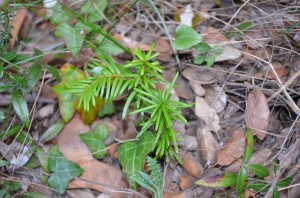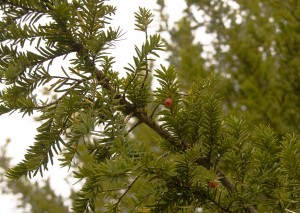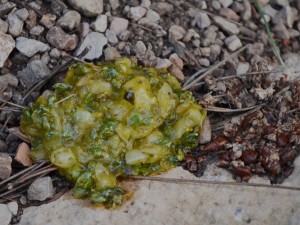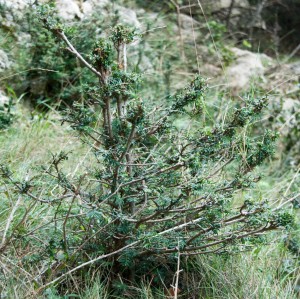Specific project Web address: http://www.taxus.cat/
Funding Agency: Comisión Europea. LIFE + LIFE11 NAT/ES/711
Participating organizations: CTFC, Consorci de Llaberia, Paratge Natural de Poblet, Ajuntament de Rasquera
Duration, from: 2012 to: 2016
Project Manager: Dr. Jordi Camprodon (Biod. & Animal Conserv. Lab) y Dr. Pere Casals
Project Researchers: Ríos AI, Taull M, Guixé D. (Biod. & Animal Conserv. Lab)
The yew tree (Taxus baccata L.) is a flagship tree, one of the longest living in the world with tremendous value as cultural, natural and scientific heritage. Regarded as a unique tree in various laws of the different countries (some of its populations are known within the habitat type 9580 * Forests Mediterranean Taxus baccata) which is listed as a priority with a wide distribution in Europe and Euro-Mediterranean, its biological conservation is justified by its rare nature. It has a wide range, but small reduced population sizes wherever it appears, and it is relict, as a species more widespread during the last glaciation, but which has now been restricted to small populations isolated from each other.
In the present context of climate change, the yew is now showing evidence of regression in southwestern Europe, placing it as a vulnerable species. Human pressure due to the changing landscape of buildings and infrastructure, for its excessive use for therapeutic purposes, for livestock, the incidence of fire and logging, has also contributed to their current worrying situation.
The broad aim of this project is to contribute to the conservation of the yew (Taxus baccata) habitat in the Northeast of the Iberian peninsula. Through specific forestry actions and environmental education activities the project aims to achieve the following specific objectives:
– to ensure the recruitment of yew populations improving seed dispersal and seedling survival
– to reduce grazing damage on Taxus juveniles
– to improve adult healthy reducing inter-specific competence for light and water
– to disseminate the conservation value of Taxus and their habitat to the general public and, specifically, to the local habitants and forestry workers or shepherds
These objectives will be achieved through the close colaboration between partners: the leadership of CTFC, with three local partners, responsible for ecological conservation and management of forested areas with important yew populations. The yew habitat (type 9580 *) is proteged in seven LIC in the NE of Spain. The TAXUS project conservation actions focuses on four of those LIC areas, which represent the most significant yew populations, and additional conservation actions addressed to not well-known yew populations in the other 4 LICs.
A1. Characterisation of new yew populations and elaboration of forest and ecological inventories. Where: Alta Garrotxa (Orri, llongarriu), Cardó (Cosp), Llaberia (1 to 10)
A2. Specific project management plan for each target sites. Where: All stands of all sites
A3. Stewardship agreements with Taxus forests landowners. Where: Alta Garrotxa (Misaclòs), Llaberia (1 to 10), Cardó (Cosp)
B1. Promotion of land stewardship agreements. Where: Llaberia (1 to 10)
Conservation measures
C1. Forestry actions to improve forest structure and growing of yew populations Where: Alta Garrotxa (Orri, llongarriu, Misaclòs), Cardó (Cosp), Llaberia (1 to 10), Poblet (1 to 9)
C2. Phytosanitary treatments to reduce the incidence of Armillaria fungi Where: Alta Garrotxa (Misaclòs), Llaberia (1 to 10)
C3. Protection of Taxus juveniles against browsing damages Where: Alta Garrotxa (Misaclòs), Llaberia (1 to 10)
C4. Collection of yew seeds and seedling production Where: all areas but Poblet
C5. Creation of “in situ” yew gardens for seedling acclimatation and growing Where: Cardó (with plants from all zones but Poblet)
C6. Reinforcement of yew recruitment through seedling planting Where: all areas but Poblet
C7. Promotion of seed dispersal fauna Where: all areas but Poblet and Misaclòs
C8. Specific fuelbreak actions to reduce the risk of wildfire spread into yew populations. Where: Alta Garrotxa (Orri), Llaberia (1 to 10), Cardó (Cosp)
C9. Slope stabilitzation in areas with a high risk of soil erosion. Where: Cardó (Cosp)
C10. Recovery encroached grasslands to reduce browsing impacts on Taxus trees in Misaclòs yew forest. Where: Alta Garrotxa (Misaclòs)
C11. Conservation actions in additional yew forests or recently discovered ones in localities non addressed by the core actions of the project. Where: other areas
Monitoring and assessment measures
D.1. Monitoring of conservation actions and evaluation. Where: all project’s areas
D.2. Creation of Assessment Comité Where: all project’s areas
Public awareness measures
E.1. Logotip design
E.2. Web design and maintenance
E.3, Divulgation to general public by design, creation and delivery of leaflets
E.4. Divulgation to general public by the media
E.5. Revalorisation of yew through an itinerant exposition
E.6. Design, creation and instalation of information boards about the project goals and natural values in each project area
E.7. Design and implementation of environmental education activities specifically addressed to local students
E.8. Participation in a Technical Workshop on Forest Management conducting two field seminars about yew management and conservation
E.9. Organization of the “IV International Meeting of Yew”
E10. Edition of a “Good Practices manual” on yew forestry and conservation
E.11. Scientific-technical communications in at least two national seminars on Agroforestry
E.12. Divulgation to specialised public by writing manuscripts for peer-reviewed journals
E13. Workshops with key local stakeholders: sheperds and forestiers
E14. Layman’s report
The overall results of the project are the improvement of the conservation status of yew populations, a priority habitat for the European Union, in four of the seven LIC where this habitat is protected in the Northeastern of Spain and an increase in public awareness of the conservation significance of yew, including key stakeholders for Taxus habitats conservation.
Specifically the expected results from conservation actions will be:
– Stewardship aggreements in Rasquera, Llaberia and Misaclòs (Alta Garrotxa) with private forest owners (A3)
– Long-term (20 years) rent of at least 15 ha of yew forest in Serra de Llaberia (B1)
– A decrease in the competence for water and light of Taxus trees through a selective clearing (25-45%) of Pinus and Quercus in: Alta Garrotxa (9 ha); Serra Llaberia (15 ha); Poblet (50 ha); Cardó-Boix (8 ha) (C1).
– A reduction of the impact of the fungi Armillaria on Taxus trees in the Misaclós Taxus forest through 22 dead trees retrivial and selective branch prunning on 204 yews in Misaclòs and 225 yews in Llaberia (C2).
– A reduction of browsing damage in about 50 yew juveniles by fencing individuals or small surfaces in a total of 7 ha in Serra Llaberia and 3 ha in Misaclòs (C3).
– Production of about 10.000 Yew seedlings (C4) and nursery acclimatation (C5) for yew population reforcing through plantation of 3500 juveniles in Rasquera and Cardo-Boix localities (C6).
– Promotion of fauna seed dispersion by atracting fauna vectors through planting high-fruit production tree species; increasing the visibility of already existing fruit trees; and increasing watering points in the Orri, Llongarriu (Alta Garrotxa), Cosp (Cardó-Boix) and Llaberia localities (C7).
– The resistence of Taxus habitats to wildfire through the reduction of fuel loads in the surroundings of Taxus forests in Orri (3.5 ha), Serra de Llaberia (28 ha) and Cardó-Boix (7,2 ha).
– A reduction of soil erosion by slope stabilization in about 1ha of yew forest in Cardó-Boix site.
– A recovery of about 3 ha of shrub encroached grassland in Misaclòs site to reduce browsing damage over yew trees.
– Conservation actions on 13.5 ha of additional yew forest with current low conservation status knowledge
Finally the project foresees specific difusion and transfer actions to general public, key stakeholders and forest technicians.
Related Papers:
Casals P, Camprodon J, Caritat A, Ríos A I, Guixé D, Garcia-Marti X, Martín-Alcón S, Coll L, 2015. Forest structure of Mediterranean yew (Taxus baccata L.) populations and neighbor effects on juvenile yew performance in the NE Iberian Peninsula. Forest Systems, 24(3): e042, 10 pages
Ríos A.I., Aguila V., Guixé D., Camprodon J., Caritat A., Casals P. 2014. Water stress (δ13C) in Taxus baccata L. depends on canopy cover and basal area of the neighboring trees. IV International Yew Workshop, October, 23-25, 2014. Poblet (Spain).
Ríos A. I., García-Martí X., Guixé D., Casals P., Caritat A., Camprodon J. 2014. Producción de plántulas de Taxus baccata para el refuerzo poblacional en las principales tejedas de Catalunya. IV International Yew Workshop, October, 23-25, 2014. Poblet (Spain).




